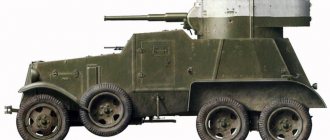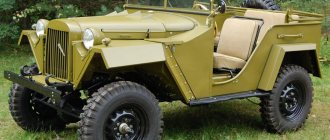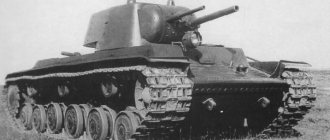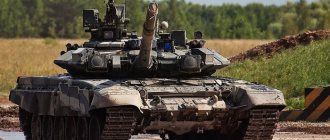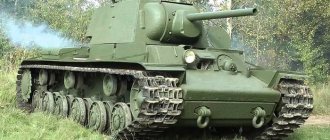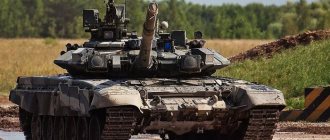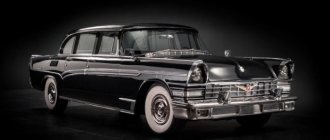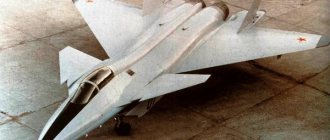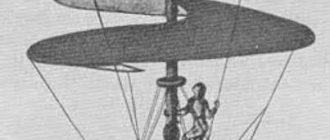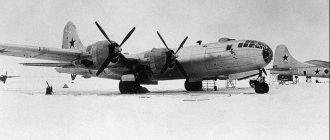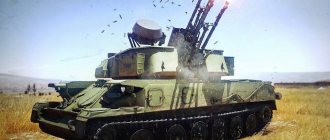The beginning of the war, which turned out to be catastrophic for the Red Army, pushed designers to create new types of weapons that had minimal manufacturing complexity. Many examples of equipment were unique to Soviet industry.
One of these developments was the BA-64, the first domestic light armored vehicle with all-wheel drive. In total, more than 9,000 vehicles were assembled, which went through the Great Patriotic War with honor, and were then used to train personnel operating the BTR-152 and 40 armored personnel carriers.
History of creation
By the beginning of the Great Patriotic War, the Red Army had several models of medium armored vehicles in service. Based on the frame and chassis of the GAZ-M1 passenger car, the only version of the BA-20M light wheeled armored car was produced.
Initially, this concept was flawed - the engine power was not enough for confident movement over rough terrain, the drive only to the rear axle limited the vehicle's cross-country ability, and the carrying capacity of the chassis did not allow increasing armor protection and expanding defensive weapons.
The offensive of the German troops led to a rapid reduction in the production of the GAZ-M1 chassis, instead of which the army utilitarian GAZ-64 SUVs began to be assembled. Most of the BA-20M armored vehicles that were in service were lost in battle or abandoned in the summer and autumn of 1941.
The idea of creating a new compact armored car on an all-wheel drive chassis arose after the start of the war.
In the second half of July at the design bureau of V.A. Grachev began development of the future BA-64. Initially, the designers planned to make do with “little loss” and simply adapt the existing armored hull of the BA-20M to the chassis of the GAZ-64. However, this idea was quickly abandoned due to layout contradictions and the general weakness of the armor.
An additional incentive was the information obtained as a result of testing captured German 2-axle light armored vehicles of the Sd.Kfz.221/222 series, which arrived in Kubinka at the end of the summer of 1941. And already in the fall, German technology was transferred to Gorky for detailed study.
The new project of a light vehicle, designated 64-B, provided for the use of short overhangs while simultaneously reducing the internal volume.
The armor protection sheets were located at different angles, which further improved the armored vehicle's protection. To increase survivability, the fuel tank was moved to the rear of the vehicle, where the risk of breaking through the tank became minimal. Because of this, it was necessary to move the driver’s workplace forward, otherwise it was impossible to accommodate a second crew member.
The creation of an armored body under the code GAZ-125 was carried out by a separate team of specialists, among whom there were experts in the field of the armored industry. The development was completed in mid-October, which made it possible to begin adapting the GAZ-64 chassis to an armored vehicle. The work was supervised by G.M. Wasserman, there were 2 designs for the chassis of the vehicle under the designations 64-E and 64-Zh.
At the end of November, the first body of the promising armored car K.E. was shown. Voroshilov, who, according to good tradition, took the development under personal control. But even without this, the developers sought to launch their brainchild into production as quickly as possible; already at the beginning of the new year 1942, the first running prototype completed a short run.
The car had an internal factory code 64-125, the first driver was the leading designer V.A. Grachev.
During the run, certain problems became apparent with the axle suspension, which could not withstand the weight of the armored hull. It was this car that was again demonstrated by K.E. Voroshilov, after which the modification of the units began. It took a particularly long time to cope with the car’s suspension elements, which failed over and over again.
In February, the car was officially shown to the People's Commissar of the Tank Industry, which at that time was V.A. Malyshev. The machine's capabilities were demonstrated in Moscow. Based on the results of the review, the light armored car received the official designation BA-64. This was followed by accelerated official field tests, and in early March the armored car was inspected by I.V. Stalin.
In mid-March, the armored car was put into service, and its developer V.A. Grachev received the Stalin Prize, III degree. Moreover, the prize was awarded not only for the creation of the Ba-64, but also for the development of the GAZ-64 off-road vehicle.
Modifications of BA-64
The BA-64 was produced from 1941 to 1946. During this time, the vehicle received many significant changes, which led to the emergence of several varieties of the serial armored car.
- BA-64B is the same armored car, but on a GAZ-67 chassis.
- BASH-646 – modification for high command.
- BA-64D – this version had a DShK machine gun with a caliber of 12.7 mm.
- BA-64V and BA-64G are two types of armored railcars capable of moving both on the ground and on rails.
- BA-643 is a tracked armored car.
Despite minor problems with the engine and suspension, the soldiers loved this baby. The best thing about the effectiveness of the BA-64 is that it went through the entire war and participated in all major battles. From 1941 to 1946, 9110 vehicles of all modifications were produced, and today the BA-64 is a glorious history of which we are rightfully proud.
BA-64, despite the short period of serial production, has a rich history. He played a significant role in the victory of the Soviet Union in World War II. The well-preserved car can be viewed in the Nizhny Novgorod Kremlin. Some technical drawings are still kept in the archives of the Gorky Automobile Plant.
Brief description of the design
The armored body of the BA-64 vehicle has a hexagonal cross-section and is made of rolled steel sheets connected by arc welding. The rational slope of the armor provides protection from rifle-caliber shell bullets at any distance; armor-piercing bullets did not penetrate the walls of the fighting compartment and driver's cabin. The armored car was protected from large-caliber bullets at distances of 500 m.
The crew got inside the BA-64 light armored car through 2 hinged doors.
The machine's turret was rotated manually; there was a brake to fix the unit in the required position. The main armament was a 7.62 mm DT-29 machine gun with 1,260 rounds of ammunition, which were contained in 63-cartridge magazines. When installing a walkie-talkie, the supply of ammunition was reduced to 1071 pieces. In addition, in the combat compartment of the vehicle there were 6 F-1 grenades and submachine guns for the crew members.
The in-line 4-cylinder GAZ-MM engine was used as a power unit on the BA-64 light armored car; in an early version of the car, the engine developed 50 hp, later the power was increased to 54 hp. To distribute torque, the BA-64 is equipped with a 4-speed gearbox and a 1-speed transfer gearbox. An unsynchronized gearbox has a blocker that prevents the simultaneous use of first speed and reverse.
The front axle of the BA-64 light armored car is mounted on 4 quarter-elliptic springs with individual shock absorbers. At the rear, semi-elliptic springs and a single-acting linkage shock absorber are used. Additionally, there is a lateral stability stabilizer, which was not used with the introduction of the GAZ-67B chassis. To turn the front wheels on the BA-64, a worm gearbox and mechanically controlled drum brakes are used.
In combat situations, tires filled with sponge rubber were used; for highway driving, standard pneumatic tires of size 7.00*16″ were installed.
The design of the new armored car BA-64
Soviet designers spent six months developing and creating a new armored car for the needs of the Red Army. Work on the creation of a new type of armored car was carried out even before the launch of the GAZ-64 car into production on an initiative basis. Six months later, on January 10, 1942, the first prototype was presented to GKO member Marshal K.E. Voroshilov. This was followed by fine-tuning the design in terms of strengthening the chassis and improving the engine base. In the design department of the Gorky plant, work was carried out on the communication and weapons systems of the new armored vehicle.
In the midst of bloody battles on the Soviet-German front in the summer of 1942, the vehicle was put into service. The first batch of new BA-64 armored vehicles, produced at the plant in Gorky before being put into production, was placed at the disposal of units of the Bryansk and Voronezh fronts for testing in combat conditions.
Unlike the old-built armored wheeled vehicles traditional for the Red Army, the new vehicle was a product of a new generation. It was a lightly armored vehicle with a 4x4 wheel arrangement.
The main running and technical characteristics of the new armored vehicle were as follows:
- combat weight - 2.36 tons;
- the length of the car was 3.66 m;
- height - 1.9 m;
- clearance height (clearance) - 210 mm;
- engine power was 50 l/s;
- highway speed – 80 km/h;
- Power reserve – 560 km.
It should be noted that leaf springs and hydraulic shock absorbers were used for the first time on an armored vehicle. This innovation significantly increased the vehicle's cross-country ability in off-road conditions. The vehicle could overcome inclines up to 400, a ditch up to 0.35 m deep, and cross water obstacles into a ford with a depth of no more than 0.9 m. The military was pleasantly pleased with the huge range that the new armored car had.
The armor protection on the BA-64 was created by welding rolled armor plates. This armored car did not have a single rivet on the body. All main elements of the armored hull had a welded connection. The main advantage of the armored vehicle was the favorable angles of inclination of the armor plates. Armor thickness is 4-15 mm. provided reliable protection for the crew and the main components and assemblies of the armored car from machine gun and machine gun fire. A turret was installed on the roof, in which there was a 7.62 mm DT-29 machine gun. The tilt angle of the machine gun made it possible to fire at both ground and air targets.
The crew of the armored car consisted of 2 people - a driver and a commander, who served as a shooter and observer.
Subsequently, the design of the armored vehicle was modernized several times, the results of which were new modifications of the armored vehicle. A total of 9,110 units were produced in 4 modifications during the war years. The BA-64 armored car went through the entire war, remaining the main armored car in the Soviet troops. The successful vehicle continued to be in service with the Soviet Army and the USSR Border Troops until 1950, when it began to be replaced by the first wheeled armored personnel carriers and combat reconnaissance vehicles (BRM).
Serial production and modifications
The first batches of BA-64 armored vehicles were assembled in Gorky already in April 1942, but shipment to the troops was delayed due to a shortage of special tires resistant to bullet holes and damage from shrapnel. The vehicles began to be transferred to the army in May, and they were equipped with bodies welded by the plant in Vyksa. Later, the production of units was transferred to Gorky, to the GAZ production sites.
In the summer, the BA-64 light armored car underwent the first change in appearance, having lost the protective nets from grenades located above the machine-gun turret.
Almost simultaneously, a ventilation hatch appeared on the armor plate located above the control post, designed to reduce the temperature inside the vehicle’s fighting compartment during the hot season. By September, an additional hatch was installed in the engine compartment, since parts began to receive complaints about the unsatisfactory cooling of the BA-64 engine.
Another object of criticism was the rear axle, in which the main pair often broke. Analysis of the data obtained made it possible to discover the cause of the defect - the movement of the BA-64 at a reduced speed without connecting the drive to the front wheels. The issue was resolved quickly and simply - they introduced permanent drive to all wheels of the car. Moreover, the BA-64 light armored vehicles that were in service with the troops were also subject to modification.
At the same time, measures were taken to further strengthen the suspension elements. So, from the end of winter 1943, the front axle of the car received 2 additional lever-type shock absorbers.
During the Battle of Kursk, German aircraft carried out a series of raids on the territory of the GAZ plant, as a result of which many production buildings were destroyed. The workshop for the production of bodies and power units used in the design of the BA-64 was especially hard hit. As a result, on June 7, the last armored car was shipped, after which production of the vehicle was stopped.
The break in production benefited the design of the BA-64, which suffered from a congenital defect - low lateral stability due to the narrow track of the base chassis.
In 1942, attempts were made to expand the track, but they were able to cope with the problem only with the development of production of the modernized army SUV GAZ-67B.
The vehicles went into production already in August 1943; outwardly they differ in the installation of machine gun armament in a closed turret. In this form, the light armored car remained on the production line until the end of the war, with the last 46 copies of the BA-64 being delivered already in 1946.
The use of the outdated DT machine gun limited the scope of use of the BA-64 light armored car, so in 1943 several experimental vehicles appeared with the SG-43 machine gun, which had belt feeding and improved ballistics. Tests showed the unsuitability of the Ba-64 turret for such weapons and further development of the project ceased.
To combat enemy lightly armored vehicles, the BA-64D variant was created, armed with a DShK heavy machine gun. Due to the increased size of the weapon, the turret and fighting compartment had to be expanded. To rotate the vehicle's turret, a shoulder strap borrowed from the T-60 light tank was used. But due to increased recoil, which rocked the unstable armored car, and problems with the supply of cartridges, the project was rejected.
Another version of the armored vehicle with enhanced armament was the BA-64 armored car with a PTRS anti-tank rifle installed instead of a standard machine gun. There were several prototypes and military improvisations on this topic. But by mid-1943, the development of such modifications of the armored car stopped.
In 1942, an original modification of the BA-64V vehicle (developed in Vyksa) appeared, equipped with steel wheels suitable for movement on railways.
The design of the vehicle included jacks designed to install standard wheels with rubber tires and to position the vehicle when installed on rails. Due to high loads, the transmission life turned out to be insufficient and the matter did not progress beyond several prototypes.
Later, a small series of vehicles was built using the BA-64B light armored car. The equipment was used to escort armored trains and patrol railways until the end of the war.
Another option was the BA-64G (created at GAZ), which was equipped with additional railway axles with small-diameter wheels. The units were placed on special lifting subframes in front and behind the body of the light armored vehicle. The movement was carried out due to the rotation of the standard wheels of the car. The design of the transmission had a reversible gearbox, which ensured the same speed forward or backward. The car did not reach mass production.
During the war, German troops widely used armored personnel carriers to transport personnel; Soviet units had virtually no such equipment (with the exception of Lend-Lease vehicles). Already in the fall of 1942, the idea arose to create a transporter based on the BA-64 armored car. The prototype of the new vehicle had an original shaped 5-seat troop compartment open at the top, located in place of the standard combat compartment.
The embarkation and disembarkation of fighters was carried out through the stern door. A little later, an experimental version of an armored personnel carrier based on the modernized BA-64B appeared. Both variants were listed as BA-64E according to factory documentation and were not built in series.
In the winter of 1942-43, a single sample of the BA-64Z light armored car was built, which was equipped with skis with a caterpillar propulsion system.
The front skis were used to change the direction of movement of the vehicle; at the rear there was a rare-link chain mounted on small-diameter road wheels. Tests showed good maneuverability with mediocre handling and increased fuel consumption. With the onset of spring 1943, the tests were completed and the idea was never returned to.
Armored car BA-64B: testing and operation
Tests and operation revealed a number of shortcomings of the armored car. The most significant was the overturning of the armored car when turning, which led to the creation of a new modification with a wider track. The armored car received a more powerful 54 hp engine. With. The new armored car received the designation BA-64B. At the end of May 1943, a decision was made to put the BA-64B into production and production of the modernized armored car was to begin in Gorky. But in June 1943, German aircraft subjected the Gorky Automobile Plant to a series of massive bombings, as a result of which the enterprise suffered serious damage.
BA-64 at the crossing of the Oder. (warbook.ru)
All this was reflected in the production of a new armored vehicle, the production of which was launched only in August 1943. Production of the BA-64 continued until 1946. A total of 3903 BA-64 and 5160 BA-64B were produced. Thus, the BA-64 and its modifications became the most popular Soviet armored vehicle and at the same time the last - in the future there was a transition to the creation of armored personnel carriers.
In addition to the mass-produced BA-64 and BA-64B, there were a number of experimental modifications. An attempt was made to strengthen the armament of the armored car by installing 12.7 mm instead of the DT-29. DShK heavy machine gun. But for this, the turret required major changes; in addition, the military was not satisfied with the small magazine capacity of 30 rounds, and the Gorky Automobile Plant refused to convert the armored vehicle into a belt-fed DShK, citing workload. As a result, the BA-64 with a heavy machine gun remained in a single copy.
Another option was an attempt in 1944 to rearm the armored car with a Goryunov machine gun, but due to the lack of a shoulder rest on this model, this idea was also not developed. An attempt was made to transform the BA-64 into an armored personnel carrier capable of transporting five soldiers. Some vehicles received improvised weapons in front-line conditions - there are examples of the BA-64 being equipped with an anti-tank rifle
Combat use
The first deliveries of BA-64 light armored vehicles began in mid-1942 to units fighting in the Bryansk and Voronezh directions. The equipment was included in the staff of tank corps, as well as the created motorcycle regiments and reconnaissance battalions.
BA-64 vehicles were used for reconnaissance and escort of infantry during urban battles, since the high elevation angle of the machine gun made it possible to fire on the upper floors and roofs of buildings. At the same time, it became clear that it was difficult for the crew to escape a damaged armored car.
Light armored vehicles BA-64 were used to a limited extent as mobile anti-aircraft guns, covering the movement of infantry columns in the front line. Anti-aircraft fire forced enemy aircraft to strike from an increased altitude, which significantly reduced the effectiveness of the strike.
In total, during the war years, about 8,200 BA-64 vehicles were delivered to the army, of which just over 3,000 examples reached victory. Soon, mass decommissioning of early light armored vehicles began; the BA-64B modification remained in service a little longer. The vehicles were used for training motorized riflemen and crews of new armored personnel carriers, and also as command vehicles until the mid-50s.
Despite the large number of vehicles produced, the BA-64 was supplied to the armies of other countries to a limited extent.
During the war, the Polish army received more than 80 light armored vehicles, which were subsequently used in battles against nationalist formations on the Polish border. In the early 50s, decommissioned Soviet BA-64Bs were transferred to Poland and were used for several years.
Czechoslovak troops who fought against the army of Nazi Germany received BA-64 armored vehicles in the summer of 1943. Several light BA-64 vehicles were also available in Yugoslav units. An unknown number of armored vehicles were delivered to the GDR, where they were used for law enforcement. There have been cases of use of the BA-64 by Chinese and North Korean troops during the Korean War, which took place in 1950-53.
Cars of the war years - BA-64, ZIS-42M, GAZ-64 jeep
When hostilities began, the Red Army had 272,600 vehicles. A considerable part of them were lost in the first months of the war, and in 1942 the country's automobile industry, with all its efforts, was able to produce only 32,300 cars. The deliveries of automotive equipment from the USA, England, and Canada that began in the same year amounted to 401,000 vehicles until the end of the war. Tens of thousands of trucks, buses, tractors, and cars entered the army and the national economy as trophies. Together they formed a very colorful park, in which products of not only German, but also Austrian, Czechoslovak, Italian, and French factories were presented. The operation of such a diverse and diverse vehicle fleet was very difficult due to the wide range of spare parts and operating materials. But at the same time, it gave designers and operators a wealth of experience in multilateral comparison of dozens of different technical concepts. On its basis, the basic requirements for post-war designs of Soviet factories were formulated, and the best engineering solutions were selected in relation to the specifics of domestic operating conditions.
During the initial period of the war, the fighting forced more than a dozen automobile industry factories to relocate to the East in a very short time, including such a gigantic enterprise as the Moscow ZIS. The evacuation, carried out in a very short time, the restructuring of the industry to work for defense, and the organization of production in new places became an unforgettable page in the history of the Soviet automobile industry. All stages of this work: dismantling equipment, unloading at new places, installing equipment and setting up production were extremely difficult and required inhuman effort. Installation work at new sites often coincided with the start of production of individual parts. High coordination of organizational work, dedication and discipline played a very important role here. The evacuation of the ZIS from Moscow began in the second half of October 1941, and at the end of the same year its workshops, relocated to the Volga and Urals, began work.
In Miass, at the automotor plant that grew up in the middle of the forest, the production of ZIS-5 engines and gearboxes began in April 1942, in July the Chelyabinsk Forging and Press Equipment Plant began producing forged and stamped parts and blanks, and in the first half of 1942 it launched the production of carburetors and radiators and other components of power supply, cooling and lubrication systems of the Shadrinsk Automotive Unit Plant. The assembly of trucks from the backlog of parts evacuated along with the equipment in May 1942 was mastered by the Ulyanovsk branch of ZIS (“UlZIS”, later UAZ). Subsequently, some of the equipment from Ulyanovsk and other cities was re-evacuated to Moscow, where ZIS resumed production of trucks in June 1942. Later, the remaining part of the equipment from Ulyanovsk arrived in Miass, where the Ural branch of ZIS, UralZIS, was formed on the basis of the automobile engine plant. Since July 1944, like the Moscow ZIS, it began to produce ZIS-5V trucks.
Thus, in 1942 and 1943, these vehicles rolled off the assembly lines of ZIS and UlZIS, and since 1944 they were manufactured by ZIS and UralZIS. , UralZIS, enterprises in Chelyabinsk and Shadrinsk were the prototype of production associations that were born in the industry much later. Managing geographically distant production facilities, coordinating their activities in wartime conditions, providing raw materials and fuel, and supplying products to the front in a precisely specified time frame was an incredibly difficult task. And the head of the industry, People's Commissar Stepan Akopovich Akopov (1899-1958), and the director of the plant, I. A. Likhachev, managed to solve it in a very short time. The change in the profile of enterprises, their evacuation, and destruction broke the already imperfect infrastructure of our automotive industry. Thus, the southern metallurgical base - the main supplier of thin steel sheets - ended up in temporarily occupied territory.
Many related enterprises, due to damage caused by the bombing of enemy aircraft, were not always able to provide automobile factories with the necessary components. At the same time, enterprises that produced carburetors, electrical equipment, tires, batteries, window regulators, instrumentation and rubber products in the pre-war years were also forced to fulfill orders from aviation, tank and other industries. It is quite natural that time shortages and lack of production capabilities dictated a completely definite technical policy. No new models were developed - they used the engineering reserves of the pre-war period. And if circumstances required the production of some other machines, preference was given to extremely simple designs, maximally unified with already developed models.
Taking into account the wartime raw materials and technological capabilities, the design of the ZIS-5 truck was revised at the end of 1941. Its layout and fundamental technical solutions remain the same. The changes were aimed at simplifying the car. The shortage of steel sheet with high stamping characteristics forced the wing blanks to be molded on a bending machine and welded, rather than stamped with deep drawing. The driver's cabin was made entirely of wood: a frame made of wooden beams, covered with clapboard. This step allowed us to save 124 kg of scarce metal on each machine. At the loading platform, only the tailgate was left folding, and the running boards were also made from wood. In order to reduce the labor intensity of manufacturing, we abandoned the front wheel brakes and simplified the design of the muffler. In addition, the cars were equipped with only one, left, headlight.
Tanks and self-propelled guns were equipped with the same headlights, and since related enterprises were already working at their maximum capacity, they had to reluctantly install one headlight per vehicle. The production of a simplified model, it received the index ZIS-5V, began in May 1942 in Ulyanovsk, and later it rolled off assembly lines in Moscow and Miass. The need to make changes was sometimes dictated by circumstances. Thus, at the beginning of December 1942, the plant that supplied steering wheels with a plastic rim for the ZIS-5V was put out of action. ZIS director I. A. Likhachev ordered in three days to design and put into production another steering wheel with wooden trim. In one night his working drawings were made and a sample was made. Three days later, trucks with wooden steering wheels were already leaving the factory gates. All models except the ZIS-5V were discontinued, including the three-axle ZIS-6.
On the basis of the main truck, a rather primitive ambulance bus ZIS-44 with a wooden body with 18 seats was produced. The chassis was used to install camping repair shops, gas stations, and special installations on them. In total, between May 1942 and May 1945, ZIS, UlZIS and UralZIS produced about 83,000 ZIS-5V trucks. The insufficient number of artillery tractors in the Red Army and the lack of off-road trucks forced a return to the production of half-track trucks in the spring of 1942. Taking the pre-war ZIS-22M model as a basis, a group of designers led by G. A. Sonkin developed the ZIS-42M with rubber tracks wider (415 mm) than on the ZIS-22. Torque was transmitted to them not through friction, as before, but through engagement, and the belts themselves had metal shoes.
The ZIS-42M was equipped with either a 73-horsepower ZIS-5 engine or its 85-horsepower modification ZIS-16. Unlike the base model, the half-track truck was equipped with a protective grille in front of the radiator and headlights, shields that prevented the frame teeth from digging into the ground, and gas tanks increased to 300 liters. The latter circumstance is explained by the fact that the very heavy (loaded weight 5250 kg) ZIS-42M, even on the highway, consumed 55-60 liters of fuel per 100 km! The highest speed is 45 km/h. Dimensions: length - 6095 mm, width - 2360 mm, height - 2950 mm; ground clearance - 395 mm. Production of the ZIS-42 began in September 1942, and their first batch arrived at the Stalingrad Front. They were used in divisional artillery and for transporting military cargo in off-road and muddy conditions. For the creation of this machine, G. A. Sonkin was awarded the USSR State Prize. In the period 1942-1944, 5931 ZIS-42 and ZIS-42M vehicles were manufactured.
In addition to the ZIS-42, in 1942 ZIS created another half-track tractor design. The AT-14 vehicle was equipped with two ZIS-16 power units (engines with gearboxes) and caterpillar units from the T-70 light tank. The tractors turned out to be bulky, and the plant produced only ten copies of them. After the outbreak of hostilities, the Gorky Automobile Plant produced GAZ-MM and GAZ-AAA trucks, GAZ-55 ambulances, GAZ-60 half-track vehicles, GAZ-05-193 staff buses, as well as GAZ-M1, GAZ-61 passenger cars, as well as GAZ-64 jeeps. Based on the GAZ-64 units, which the plant mastered in the fall of 1941, a group of specialists under the leadership of V. A. Grachev developed the BA-64 armored car. Its production began in the spring of 1942, and in the summer the new vehicles already took part in combat operations on the Bryansk and Voronezh fronts.
The basis of the BA-64 was a welded hull with armor plates, which were given a significant slope. Despite their small thickness (from 4 to 15 mm), it had good bullet resistance due to the ricocheting of bullets and fragments. In an effort to reduce the affected area as much as possible, the designers made the machine very compact. So, the driver sat in the center of the car, and the second crew member, who was also the commander and gunner, was behind him and a little higher. Small front and rear overhangs of the hull, a fairly large (210 mm) ground clearance, all-wheel drive and tires measuring 7.00-16 inches with large lugs provided the armored vehicle with good cross-country ability. He overcame slopes of up to 30° on hard ground, as well as slopes of 18° with slippery soil.Bullet-resistant tires filled with sponge rubber and triplex glass ensured the survivability of the car. He was armed with a 7.62 mm machine gun mounted in a turret with all-round firing. Some of the vehicles received a 14.5 mm anti-tank rifle instead of a machine gun. Most BA-64s had a duplex radio. GAZ-64 engine with 50 hp power. provided the armored vehicle with a speed of up to 80 km/h and a relatively large reserve of traction for driving over terrain. The vehicle had a combat weight of 2425 kg and very modest dimensions: length - 3660 mm, width - 1680 mm, height - 1900 mm. The wheelbase was 2100 mm and the track was 1250 mm. Due to the narrow track, the BA-64 was not sufficiently stable in the lateral direction. Therefore, in the spring of 1943, it was replaced by the BA-64B, whose track (like the GAZ-67) was expanded to 1446 mm, and the front wheel suspension was supplemented with two more shock absorbers.
BA-64 and BA-64B proved to be successful machines, and for their creation V. A. Grachev was awarded the State Prize in April 1942. There were many modifications of the BA-64B: armored handcars - BA-64V and BA-64G (December 1942), the BA-64D vehicle with a large-caliber (12.7 mm) machine gun (spring 1943), the turreted BA-64E armored personnel carrier on six fighters and other varieties. Production of the BA-64B ceased in 1946. Modernization affected the GAZ-64 jeep at the end of 1942. First of all, it is associated with an increase (from 1250 to 1466 mm) gauge. Accordingly, the body was equipped with wings protruding beyond the surface of its sidewall, and the rear overhang was shortened. The engine also underwent reconstruction, in particular, it received a new carburetor with a falling mixture flow, which was accompanied by an increase in power from 50 to 54 hp. In addition, a thermostat was included in the GAZ-M engine cooling system and the water pump was connected differently.
All-wheel drive, favorable distribution of total weight along the axles (42.5% on the front, 57.5% on the rear), fairly high ground clearance (210 mm) and good traction characteristics of the engine predetermined the high cross-country ability of the GAZ-67. Without snow chains, the car easily walked on virgin snow, 350 mm deep, and climbed 10° inclines. With chains, he overcame snow-covered climbs of 20°. The car could carry four people and tow a trailer weighing 800-1000 kg. The unpretentious engine could run on any type of gasoline - an important circumstance in military conditions. Fuel consumption with octane number 66 was 16-18 liters per 100 km. The fuel supply (70 l) was located in two tanks. With a curb weight of 1376 kg, the GAZ-67 reached a speed of 90 km/h. Its traction capabilities can be judged by the fact that in low gear it developed a force 18% greater than the famous American jeeps of that time, the Willys-MB and Ford GPV.
In difficult road conditions, with low gear engaged, its maximum speed, corresponding to the highest torque mode, was 6.9 km/h, i.e. It was practically close to walking speed. The Willys and Ford cars had less flexible engine characteristics and, in addition, due to the narrow wheel track, had insufficient lateral stability. Due to the absence of doors (they were replaced by cutouts in the sides of the body), the GAZ-67 allowed passengers to quickly leave the car if necessary. With the awning folded and the windshield lowered onto the engine hood, the car was easily camouflaged, since its height in this case was reduced to 1250 mm. The dimensions of the car were determined by the following data: length - 3345 mm, width - 1720 mm, height (with the awning raised) - 1700 mm, wheelbase - 2100 mm.
This Soviet jeep, which was very successful in design, underwent further modernization in detail in 1944, which was reflected in its index - GAZ-67B. A small number of GAZ-67B cars were equipped with two-door closed bodies, which were manufactured not by GAZ, but by one of the body factories. These cars were called GAZ-67-420. In total, from 1942 to 1953, 62,843 copies of the GAZ-67 and GAZ-67B were manufactured, and about 5,300 vehicles were produced between 1942 and 1945. The main GAZ cargo model, like the ZIS-5V, has been simplified. It lost its bumper, front wheel brakes, and nickel-plated emblem on the radiator. The picture was completed by a wood-canvas cabin instead of a steel one, bent welded wings, and non-folding side walls of the cargo platform. Until 1943, the GAZ-MM and its derivatives were produced without doors (they were replaced by canvas canopies) and right-hand headlights. This simplified modification did not have its own index.
During the war, the Gorky Automobile Plant played the role of not only a leading supplier of cars (102,300 from June 22, 1941 to May 9, 1945), but also light tanks and self-propelled guns. Therefore, the enemy has repeatedly tried to disable the GAZ. He carried out the heaviest bombings on the eve of the Battle of Kursk, when from June 4 to July 5, the Nazis carried out 25 raids on the plant. As a result of the destruction, the enterprise suffered great damage, the production cycle was interrupted, and about 50 buildings and structures were seriously damaged. Restoration of the plant, according to some experts, required at least a year. To take decisive measures for speedy reconstruction, People's Commissar of Medium Engineering S.A. Akopov came to Gorky. About 35 thousand repairmen, installers, and builders who arrived at GAZ, working 18-19 hours a day, raised the plant from ruins in 100 days. On October 28, 1943, car manufacturers and builders reported to the State Defense Committee about the restoration of the enterprise.
At the end of 1943, GAZ resumed production of only the GAZ-MMV, GAZ-67, GAZ-55 and BA-64B cars. The production of GAZ-AAA three-axle vehicles and other vehicles based on them, as well as the structurally “raw” GAZ-60 half-track vehicle, was discontinued. The production of the GAZ-61 and GAZ-M1 passenger cars, which the plant produced in small batches until the summer of 1943, was also curtailed—there was not enough thin steel sheet for stamping body parts. At the same time, at GAZ, as well as at ZIS, the assembly of army vehicles supplied under Lend-Lease was underway: Ford, Chevrolet, Dodge, etc. As for YAZ, it continued to produce in very small quantities YAG-6A trucks until the beginning of 1942. At the end of the same year, the plant received the task of mastering the production of a tracked tractor for towing artillery systems. Its design was developed by NATI in 1941.
The production of these cars - they received the index Y-11 - with two six-cylinder GAZ engines with a power of 70 hp each. planned to deploy in June 1943. However, the GAZ engine workshop, destroyed by enemy bombers, could not provide YaAZ with engines. A different engine was needed. And then they remembered the negotiations with American companies that began just before the war about equipping the future YAZ engine production with machine tools. He was to produce a family of two-stroke diesel engines called "Jimsi". Deliveries from the USA of four-cylinder engines of the model “4-71” with a power of 110 hp included in this family. solved the problem of the power plant of the Yaroslavl tractor. Redesigned for a new engine, it received the I-12 index and began production in August 1943. This vehicle had high maneuverability, good maneuverability and reached a speed of 37 km/h on the highway, and 16 km/h on a dirt road.
Ya-12 tractors, which were used to tow corps artillery guns weighing up to 5 tons, sharply increased their mobility and thereby radically changed the tactical capabilities of this type of artillery system. But supplies of imported diesel engines soon stopped, and the YaAZ team reconstructed the tractor to install a six-cylinder ZIS-5MF carburetor engine with a power of 95 hp. The new model received the index Ya-1ZF. In the first months of the war, the Moscow KIM plant produced a small number of staff vehicles on the KIM-10 chassis with a simplified body. In the fall of 1941, the plant was evacuated to Sverdlovsk, where it joined the enterprises that manufactured tanks. In Moscow, in the buildings of the KIM plant, tank diesel engines were being repaired and spare parts were being manufactured for vehicles supplied under Lend-Lease. In the final period of the war, design bureaus of the automotive industry again turned to new developments.
They concerned both military vehicles and models, the production of which was to begin after the victory over the enemy. A very original car was built at GAZ by V. A. Grachev. Focusing on the prototypes of the post-war GAZ-bZ all-terrain truck, prototypes of which were tested back in 1940-1941, he developed a project for the KSP (wheeled self-propelled gun), also known as the GAZ-68. Its first and only copy was ready in May 1944. The low armored hull, open at the top, housed a 76.2 mm gun. The driver was sitting on the right. The power unit (GAZ-202 engine, a version of the GAZ-11 with a power of 85 hp) was located at the rear. All wheels are single-wheel drive, and the front drive was permanent, and the rear drive was switchable. With a combat weight of 5340 kg, the GAZ-68 developed a speed of 77 km/h on the highway and had very good cross-country ability. However, when testing of this vehicle ended in November 1944, there was no longer any urgent need for it on the part of the army.
Another interesting GAZ development is a half-track modification of the BA-64B armored car. Instead of rear drive wheels, at the suggestion of engineer S. S. Stroev, at the beginning of 1943 it was equipped with a chain ski-track propulsion unit, the idea of which was put forward by the outstanding domestic engineer and inventor S. S. Nezhdanovsky, who received a patent for the invention of such a propulsion device on August 31, 1925 . The BA-643 half-track armored car walked confidently through the virgin snow, overcoming inclines of 18°. However, the insufficiently high performance of the basic model in relation to the use of such a crawler did not allow the continuation of experimental work. Another direction of half-track vehicles was developed by ZIS specialists. This plant built several AT-8 and AT-14 half-track vehicles, equipped with two 3IS-5MF engines with a total power of 150-190 hp. Each served a small-link all-metal track on one side.
But the main direction of experimental design work of this period was the creation of new post-war models. The desire to provide them with high performance indicators, refusal to a large extent from continuity with pre-war vehicles, rich experience in operating captured vehicles and equipment received under Lend-Lease, the planned transition to new technology - these were the determining factors that guided the specialists of our factories. Before the war, trips of our designers abroad to automobile exhibitions or factories were a rare occurrence. Acquaintance with the latest technological achievements occurred either sporadically, without a system, purchased samples, or from technical periodicals acquired by the industry rather sparingly. Captured cars that came from many European countries and arrived under Lend-Lease could not only be disassembled, thoroughly studied, analyzed, but also tested in domestic conditions.
A lot of automotive equipment was repaired, in particular in 1942-1945 at the former KIM plant, which provided invaluable information about the durability and maintainability of components and parts of foreign cars. At ZIS, work on new models began in 1942: first on a passenger car (headed by A. N. Ostrovtsov), later on a truck (G. A. Festa). In September, the State Defense Committee approved a sample of a new passenger car, the chassis of which was identical to the American Packard 180 of 1942. This executive car, the first prototype of which was sent for testing on August 11, 1945, began to be produced in small series in July 1946. Tests of prototypes of the ZIS-15, developed before the war, showed that for the car that should replace the ZIS-5 on the assembly line, the engine power is 80 hp. not enough. Therefore, first of all, in 1943, ZIS began designing a new engine and five-speed gearbox.
In the summer of 1944, prototypes of the post-war ZIS-150 truck were already being tested. At the same time, work was underway on its all-wheel drive modification ZIS-150P, which never left the experimental stage. The Gorky Automobile Plant resumed the design and construction of prototypes of new cars, interrupted by the war. Already on February 3, 1943, the chief designer of GAZ A. A. Lipgart, at a meeting of designers of automobile factories and related enterprises, reported on the progress of work on the passenger model GAZ-20 and trucks GAZ-51 (4X2 wheel arrangement), GAZ-bZ (4X4), GAZ-ZZ (6X6). The first prototype of the GAZ-20 was ready on November 6, 1944. A. A. Lipgart himself took him out of the factory gates for his first tests. Diesel trucks were destined to become the main product of YAZ in the post-war years. In November 1944, a large group of specialists left for the USA to place orders for engine shop equipment. Until 1946 they received 350 machines.
At the same time, the production of a prototype diesel model with a lifting capacity of 7 tons began in Yaroslavl - chief designer G. M. Kokin. The first prototype of the YaAZ-200 was ready in December 1944. If the YaAZ-200 was supposed to be equipped with a four-cylinder 110-horsepower two-stroke diesel engine, then a three-cylinder 83-horsepower model of the same family was intended for the new ZIS-253 truck with a load capacity of 3.5 tons, which was designed under the leadership of UlZIS chief designer B. L. Shaposhnik ( 1903-1985). This truck was conceived as unified with the ZIS-150 cargo model. The first sample of the ZIS-253 was assembled by Ulyanovsk residents on May 1, 1944. The third plant, which was planned to specialize in the production of diesel cars, began operating at the end of 1944 in Minsk. The fascist occupiers decided to build a car repair and assembly plant on the outskirts of the city. After the liberation of the city, the assembly of cars that came to the USSR under Lend-Lease began in its buildings.
The necessary equipment and personnel for this production arrived from GAZ, where the installation of these cars had been curtailed since October 1944. In November 1944, MAZ assembled and sent the first 50 trucks to the front. In the future, the plant was to produce dump trucks of the 205 model developed at YAZ, and already in October 1945 G. M. Kokin became the chief designer of MAZ. Thus, even during the Great Patriotic War, the foundations of the post-war technical policy were laid, the design of new models was in full swing, prototypes were built and tested. The preparatory work begun in advance allowed the Soviet automobile industry to master new models already in 1946-1947 significantly earlier than the industry of England, the USA, France, and Italy.
Technical characteristics and analogues
Compared to its predecessor BA-20M, the new Soviet light armored vehicle BA-64 had improved armor, with some of the front plates being up to 20 mm thick. The use of inclined sheets and the use of a short-wheelbase chassis made it possible to maintain constant weight and dynamics.
A tank of 90 liters of gasoline located in the stern provided a cruising range on the highway 1.5-2 times greater than that of its analogues.
| BA-20M | BA-64 | Sd.Kfz.221 | |
| Combat weight, kg | 2320 | 2360 | 4000 |
| Armor thickness, mm | 3-9 | 8-15 | 8-10 |
| Crew, people | 2-3 | 2 | 2 |
| Motor power, hp | 50 | 50 | 75 |
| Travel speed, km/h | 90 | 80 | 90 |
| Cruising range on the highway, km | 450 | 600 | 320 |
The German light armored car Sd.Kfz.221, which partly served as a prototype, has 2 times the weight. The installation of a 6-cylinder engine with increased power equalized the dynamics of the cars. But due to the increased displacement and greater weight, fuel consumption also increased, which had a detrimental effect on the range.
The armament of the German vehicle consisted of an MG34 machine gun, which was later replaced by a 20mm automatic cannon. Also on the Eastern Front there were vehicles armed with a 28 mm s.Pz.B.41 anti-tank rifle. The design of the BA-64 light armored vehicle did not allow for a worthy response to such modernization.
The BA-64 armored car is a typical product of the war era, which was extremely in demand during hostilities, but in peacetime turned out to be unsuitable for use. Due to intensive and rapid decommissioning, only a few copies of genuine BA-64 light armored vehicles have survived to this day, which are located in Moscow, Nizhny Novgorod and Vladivostok.
In the Moscow region there is an original BA-64B, which was restored from the found wreckage of several vehicles.
Also in Russia there are several new-made cars installed on the GAZ-69 chassis.
The BA-64 war machine is not popular with scale model manufacturers either. In the popular 1-35 scale, there is a product from, which is very vaguely similar to the prototype and is extremely capricious to assemble.
